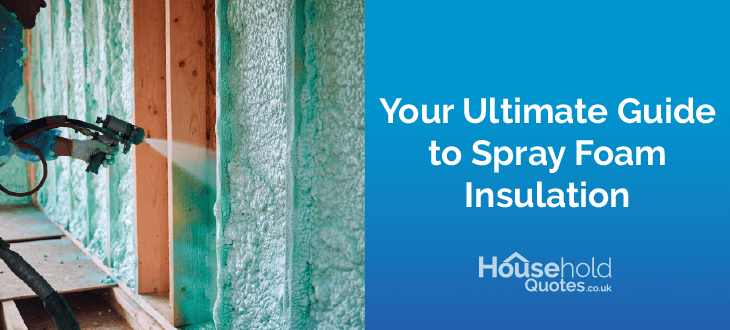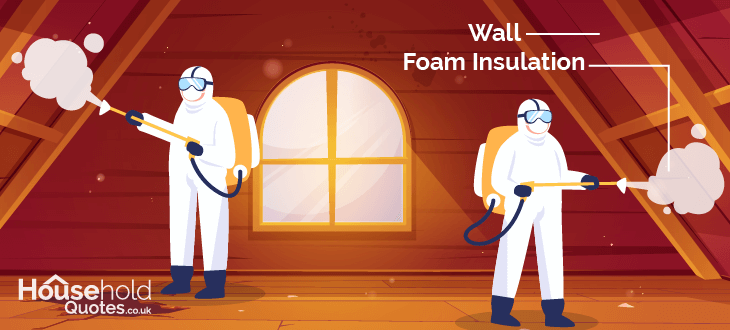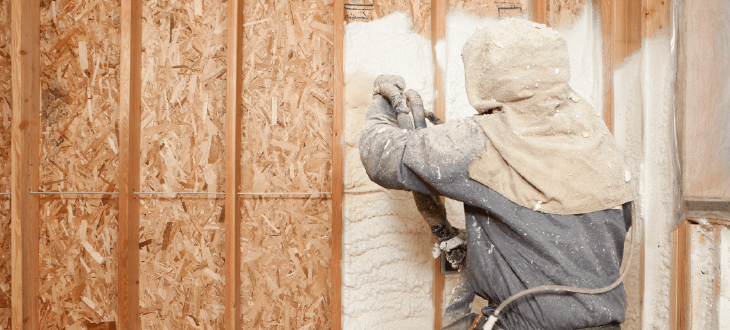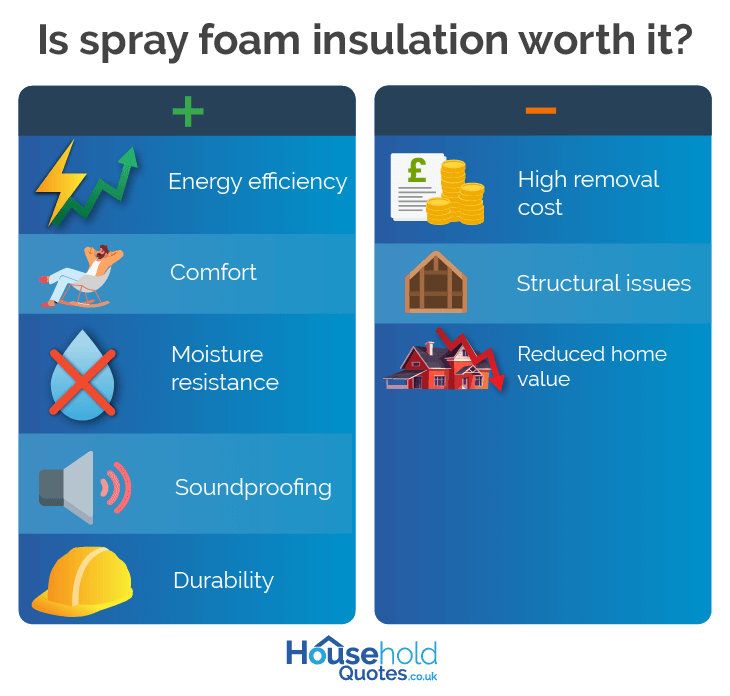
Tell us what you need to find a matching loft conversion specialist

Get free quotes from professionals near you

Compare offers and choose the one that best matches your need
- Householdquotes.co.uk
- Home Insulation
- Spray Foam Insulation
Your Ultimate Guide to Spray Foam Insulation


- Spray foam insulation can reduce annual heating and cooling costs by an average of 50%.
- Spray foam insulation lasts longer than fibreglass; reaching up to 80 years.
- Spray foam insulation is a great noise insulator, improving sound reduction for your property.
Spray foam insulation may have a higher price tag but offers exceptional home insulation. However, is it worth the investment? It’s crucial to understand its advantages and limitations. This Household Quotes UK guide outlined the benefits and drawbacks to ensure you have all the information needed to make an informed decision.
Are you planning to insulate your home? Let Household Quotes UK handle all the tedious research and vetting for you. Instead of spending endless hours scouring websites and setting up appointments with installers, fill out our quick online form in just 30 seconds, and we'll provide you with up to 3 free quotes from professional installers in your local area. Click the button below to get started!
Fill in the form in just 1 minute
What is insulation foam?

Spray foam insulation is a modern and efficient solution for sealing and insulating buildings. It is generally made from polyurethane and is applied as a liquid that rapidly expands into a thick expanding foam, creating an airtight barrier.
This insulation method offers excellent thermal resistance and can cut energy costs by 50% by preventing heat loss in winter and heat gain in summer.
Spray foam insulation is typically applied using a specialised spray gun. The process involves isocyanate and polyol resin, which are stored in separate containers and mixed at the spray nozzle.
When these components combine, they react and expand rapidly, forming a foam that sticks to surfaces. The foam fills gaps, cracks, and voids, creating an airtight and waterproof seal. This application can be used in various building parts, including walls, ceilings, floors, and even hard-to-reach areas like crawl spaces and attics.
There are two main types of spray foam insulation: open-cell and closed-cell. Each type has distinct characteristics and benefits, making them suitable for different applications.
Open-cell spray foam
Open-cell spray foam is lighter and less dense than closed-cell foam. It has a sponge-like texture due to the intentionally left open cells within the foam. This structure allows air to fill the gaps inside the material, making it highly flexible and expand up to 100 times its original size.
Here are some key features of open-cell spray foam:
- Density: Typically around 0.5 pounds per cubic foot.
- R-value: Approximately 3.5 to 3.6 per inch. The R-value measures thermal resistance, with higher values indicating better insulating properties.
- Soundproofing: Excellent at absorbing sound, making it ideal for reducing noise transmission between rooms.
- Cost: Generally more affordable than closed-cell foam.
- Applications: Open-cell spray foam is often used in interior applications where moisture resistance, such as walls and ceilings, is not a primary concern.
Closed-cell spray foam
Closed-cell spray foam insulation is denser and more rigid than open-cell foam. It consists of entirely closed cells, preventing air and moisture from entering. This type of foam provides a higher R-value and acts as a vapour barrier, adding structural strength to buildings.
Critical features of closed-cell spray foam include:
- Density: Typically around 2 pounds per cubic foot.
- R-value: Approximately 6 to 7 per inch, making it one of the highest R-values among insulation materials.
- Moisture resistance: Acts as a barrier against moisture, making it suitable for areas prone to dampness or flooding.
- Structural integrity: Adds rigidity and strength to walls and roofs.
- Applications: Closed-cell spray foam is ideal for exterior applications, basements, crawl spaces, and any area requiring high insulation performance and moisture protection.
Spray foam insulation cost
Spray foam insulation costs typically range from £3.50 to £7.00 per square foot (around £20 to £55 per square metre), depending on several factors:
Although initially more costly than traditional insulation methods, spray foam insulation offers substantial long-term savings through improved energy efficiency.
Insulation costs in the UK vary due to several factors. These include the type of foam used, whether it's open-cell or closed-cell, the size of the area that needs insulation, and the regional labour rates. To give you an idea, here's a breakdown of the average expenses homeowners can expect:
| Spray foam material | Cost per m² |
|---|---|
| Open cell | £35 - £70 |
| Closed cell | £40 - £55 |
Spray foam insulation removal cost
Removing spray foam insulation presents a multifaceted and potentially costly undertaking, particularly in the case of erroneous installation or degradation over time. This document offers an overview of the expenses and procedures of removing spray foam insulation.
The cost of removing spray foam insulation varies depending on the extent of the installation, the type of foam (open-cell or closed-cell), and the area's accessibility. On average, homeowners can expect to pay:
- Open-cell spray foam removal: £15 to £25 per square metre (£1.39 to £2.32 per square foot).
- Closed-cell spray foam removal: £20 to £35 per square metre (£1.86 to £3.25 per square foot).
The costs for removing spray foam insulation can include labour and disposal fees, which may increase if additional work, such as repairing the underlying structure, is necessary. The process involves assessment, cutting and scraping, vacuuming and cleaning, as well as repair and restoration. It can be costly and time-consuming, but it is necessary in some cases.
Homeowners should understand the costs and processes involved to make informed decisions. Consulting with experienced professionals is crucial for safe and effective removal, restoring the home's comfort and efficiency.
Applications of spray foam insulation

Spray foam insulation is a great way to make homes and buildings more energy-efficient and comfortable. It can be used in different ways, such as on roofs, lofts, underfloors, and walls, to reduce noise.
Roofs
Spray foam roof insulation improves a building's thermal performance. It creates a seal that stops heat from escaping in winter and entering in summer. This lowers energy use and costs for heating and cooling.
Additionally, it adds structural strength to the roof and protects against moisture, preventing mould and mildew. The durable insulation lasts through various weather conditions, contributing to the roof's lifespan.
Lofts
Home lofts can lose up to 25% heat via the roofs/lofts, but loft insulation spray foam can help. This insulation fills gaps and spaces effectively and helps with soundproofing, making the loft space quieter. It can also make the indoor temperature more consistent throughout the year.
Using open-cell spray foam is common for lofts because it seals air well. Additionally, insulating the attic can make the home more energy efficient, reduce utility bills, and improve indoor comfort.
Underfloors
Underfloor spray foam insulation is very effective. It helps keep cold air out and makes the living spaces warmer and more comfortable. Closed-cell spray foam is used for underfloor insulation because it's solid and moisture-resistant.
This is especially helpful in homes with unheated basements or crawl spaces, as it can reduce drafts and keep the indoor temperature stable. Underfloor insulation can also lower energy bills by reducing the need for extra heating.
Cavity wall
Spray foam cavity wall insulation can make buildings more energy efficient. It fills the space between exterior and interior walls, creating a barrier that reduces heat loss and air infiltration. This helps keep indoor temperatures consistent and lowers energy use and costs.
The foam fills even the smallest gaps, providing better insulation than traditional methods. Additionally, cavity wall insulation can help prevent moisture buildup, reducing the risk of mould and structural damage.
Acoustic
Spray foam insulation is excellent for reducing noise. It expands to fill gaps, dampening sound through walls, floors, and ceilings. Open-cell spray foam is perfect because its porous structure absorbs sound waves and lowers noise levels.
It's ideal for homes, offices, and other buildings where reducing noise is essential. Using spray foam for acoustic insulation can make indoor spaces more comfortable and private by reducing outside noise and improving overall sound quality inside the building.
Advantages of spray foam insulation
Spray foam insulation is a highly effective material for insulating homes and buildings. It offers many benefits that can lead to significant long-term savings and improved comfort. Here are some of the critical advantages of spray foam insulation:
Thermal performance
Spray foam insulation is better at keeping your home's temperature consistent than traditional materials like fibreglass or cellulose. It seals tightly, so you lose less heat in the winter and gain less heat in the summer. This can cut your heating and cooling costs by up to 50%.
Energy savings and payback period
While the initial cost of spray foam insulation can be higher than that of other types of insulation, the energy savings it provides often lead to a quick payback period. Homeowners can expect to see a return on their investment within 3 to 5 years, depending on factors such as the size of the home, local climate, and energy prices. Significant energy savings can be realised in as little as one year.
Moisture and mould resistance
Spray foam insulation helps keep out moisture, stopping water from getting in and reducing the chance of mould and mildew growing. It's beneficial in areas that are often damp or prone to flooding. Closed-cell spray foam is very good at resisting moisture and adds a layer of protection to the building structure.
Structural integrity
Closed-cell spray foam insulation not only insulates but also strengthens the structure it is applied to. It adheres to surfaces and adds rigidity to walls, roofs, and other structural components, improving a building's durability and longevity.
Soundproofing qualities
Open-cell spray foam insulation is excellent at reducing noise. It works well for homes, offices, and other buildings where noise reduction is essential. This can make indoor spaces quieter and more comfortable.
Environmental benefits
Spray foam insulation helps the environment by cutting energy use and greenhouse gas emissions. It makes buildings use less energy for heating and cooling, reducing the need for fossil fuels and shrinking their carbon footprint. Some spray foam products are also made with renewable or recycled materials, making them even more eco-friendly.
Versatility and coverage
Spray foam is versatile and can be applied to different surfaces and hard-to-reach areas to ensure complete coverage and eliminate gaps and voids missed by other insulation types. It is suitable for various uses, including roofs, lofts, underfloors, cavity walls, and acoustic insulation.
Spray foam insulation problems and how to overcome them
Spray foam insulation offers multiple benefits, but improper installation can lead to issues. To avoid these problems and enjoy all the benefits of this effective insulation material, it's crucial to use a certified insulation installer.
Common issues and solutions:
- Poor air circulation and ventilation: Incorrect installation can reduce ventilation in roof spaces, leading to moisture buildup.
- Dampness and condensation: Improper application can trap moisture, causing dampness and mould.
- Risk to timber-framed roofs: Poor installation can trap moisture against timber, leading to decay.
- Always insist on professional installation rather than attempting a DIY approach: Professionals possess the knowledge, experience, and equipment to deliver a top-quality job with long-lasting results. Furthermore, their services typically include a 25-year guarantee, offering assurance in the event of any issues.
Spray foam insulation mortgage problem
Spray foam filler must be installed professionally to avoid mortgage issues. Improper installation can lead to problems like reduced ventilation, dampness, and structural decay, affecting your home's value and making it difficult to get a mortgage or refinance. By ensuring spray foam insulation is professionally installed, you make it easier to sell your home and lower the risk of mortgage approval issues. This will give you peace of mind that your home is well-insulated and its value is protected.
When you're in the process of buying a home, it's essential to prioritise professional installation of spray foam insulation. Avoid the temptation of DIY installations and instead, seek expert advice to make an informed decision.
Keep in mind that some mortgage lenders may have reservations about spray foam insulation in homes, so it's always wise to check with them for specific requirements. Improperly installed spray foam insulation can complicate mortgage processes, underscoring the need for professional installation and expert guidance.
Is spray foam insulation worth it?

If professionals install spray foam insulation by industry standards, it will deliver a substantial return on investment. The benefits include:
- Energy efficiency: Reduces heating and cooling costs by up to 50%.
- Comfort: Provides superior thermal insulation, maintaining consistent indoor temperatures.
- Moisture resistance: Prevents mould and mildew growth by creating a moisture barrier.
- Durability: Enhances structural integrity and lasts for decades.
- Soundproofing: Reduces noise transmission for a quieter home.
Attempting a DIY installation of spray foam insulation can lead to significant problems, making it not worth the investment:
- High removal costs: Improper application often necessitates costly professional removal.
- Structural issues: Incorrect installation can cause moisture buildup, mould, and damage to timber-framed roofs.
- Reduced home value: Homes with DIY spray foam insulation may need help securing mortgages and resale.
In short, hiring a certified professional to install spray foam insulation is a good investment. It provides great energy savings and long-term benefits. However, if you try to install it yourself, you could end up with high removal costs and serious problems, making it a bad investment. It's always best to have professionals handle the installation to get the most out of it and avoid any issues.
Spray foam insulation grants
The ECO4 scheme is now open to new applicants, offering a government grant for spray foam insulation to make homes more energy-efficient. Eligibility criteria have changed, so it's important to check with us before applying.
You might also be eligible for funding under the Great British Insulation Scheme. Certain major energy spray foam companies offer free insulation grants for home improvements as part of a government scheme, with the grant amount depending on the company's number of customers.
Alternative types of insulation
Several great alternatives exist if you think that spray foam insulation is too risky or unsuitable for your needs. Each type has its benefits, so it's worth exploring these options and getting quotes to find the best solution for your home.
- Fiberglass insulation: This insulation is made from fine glass fibres and is commonly used. It is affordable, easy to install, fire-resistant, and reduces heat transfer. It is ideal for walls, attics, and floors.
- Cellulose insulation: This insulation is made of recycled paper products and is treated with fire retardants. It is suitable for the environment, provides good thermal performance, and has soundproofing qualities. It can be used for walls and attic spaces.
- Mineral wool (rock wool) insulation: This is made from melted rock spun into fibres. It is highly resistant to fire and provides excellent soundproofing and thermal performance. This material is great for use in attics, walls, and floors.
- Reflective or radiant barrier insulation: This material uses reflective materials such as aluminium foil to reflect heat. It is effective in hot climates, reducing cooling costs by reflecting radiant heat away from living spaces. They are commonly used in attics.
Household Quotes UK can simplify the process for you. Instead of spending endless hours scouring websites and setting up appointments with installers, you can fill out our quick online form in just 30 seconds. We'll take care of all the tedious research and vetting and provide you with up to three free quotes from professional installers in your local area. Click the button below to get started!
Fill in the form in just 1 minute
FAQ
Spray foam insulation is considered safe when installed by spray foam insulation contractors. Once cured, it is non-toxic and offers exceptional thermal insulation and air sealing properties.
The downside of spray foam insulation is that improper installation can cause moisture buildup, mould growth, and structural damage. It can also be more expensive upfront compared to other insulation types.
No, you can’t spray foam insulation yourself. DIY installation can lead to significant problems, high removal costs, and safety risks. It is crucial to always use a professional installer.
Yes, ensure that the insulation was professionally installed and inspected. Be vigilant for any signs of moisture or structural issues, and beware of homes with DIY spray foam installations.
Yes, many mortgage lenders generally accept professionally installed spray foam insulation. However, it is crucial to verify each lender’s specific requirements and policies.

Akif has a keen interest in green home improvement solutions and the role of digital media in identifying climate trends. He aims to provide a multidisciplinary approach to content rooted in credible research and accuracy.
